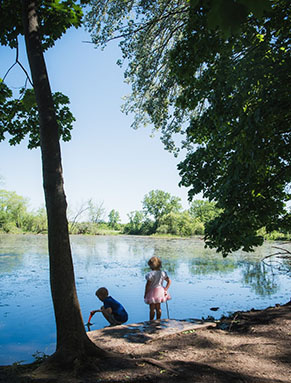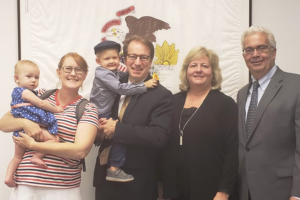By Beth Orchard
The new year has just begun. How are we all doing with those resolutions? Some research says it takes 21 days to make a habit. Other research says longer, but don’t count on it sticking around if you don’t do XYZ.
If I’m being honest, I find resolutions to be binding and torturous to my mental health. I stopped doing them a few seasons ago. One thing I learned about having kids, especially Liam, who needs a lot of medical attention, is to find a more sustainable and healthy rhythm to give me life in the new year.
Here are a few ways to look at more supportive pathways to better mental, physical, and spiritual wellness in 2025 (and beyond).
Mind Your Social Media Consumption
One of the things I absolutely love about the National Foundation for Ectodermal Dysplasias (NFED) is the way it builds connections with people from all over the world. Because of my social media presence, I have stayed in touch with friends I meet at NFED Family Conferences.
I have also met with people long after the conference ended with help from my social apps. I have also planned and attended fundraisers, events, and other gatherings solely based on using social media. There is an upside, but there is also a shadow side to social media consumption.
Experts talk about how detrimental it can be for our health as adults, but it is just as challenging for young people to navigate it.
While there are myriad reasons for this, my focus for our family this year is to look at how to have a healthier relationship with our social media and phone apps.
Liam loves my two game apps. Iona loves to do learning apps. I poke around game apps but mostly I like to (doom) scroll, post, like, and share on social. To me, it is like building bridges with people. However, it is exhausting to keep up with, and I am inundated with advertisements, content, and information overload daily.
Social media consumption also affects my sleep and overall mental health. Take a moment to get an app that will tell you how much time you spend on social media. You may be shocked at how much time is spent on it. Then, determine what a healthy relationship looks like for you this year.
You’ve Got to Move It, Move It
If you ask anyone what their New Year’s resolutions are, almost everyone will respond with some version of “get healthier,” “exercise more,” or “hit fitness goals.” If you are in that category, you are not alone. Everyone, from kids to seniors, needs some form of exercise. Not only does it do a body good, but it also boosts brain chemicals that make you feel better.

For me and our family, it is a must. Iona is incredibly active and needs physical movement to regulate her body and emotions. The winters can be challenging because, although the school promotes physical activity and recess, it is too dark to be outside after school is out.
Weekends are challenging when bitter temps here in Chicagoland keep us stuck indoors. Liam gets too hot when it is around 80 degrees outside, so we need alternatives. For us, movement and mental health are deeply linked and require us to think outside the box and be creative.
Take These Tips for Better Mental Health:
- Join a gym. Find a local place within your budget to help you move your body. Some offer childcare.
- Find an accountability partner and do online videos for free. There are many to choose from that will help you get motivated to move, dance, and shake your way into the new year.
- Build momentum by getting outside when possible. Grab a friend, walk a dog (or a friend’s dog), ride a bike,or try something or somewhere new to motivate you to enjoy walking and moving
- Don’t let excuses drag you down. Even with physical limitations, it is still possible to engage the body in tiny movements that help boost your mental state
- Watch the junk food (carbs, sugar, caffeine). These will make it harder to lose weight. Not sure where to start? Speak with a nutritionist, dietitian, or other professional who can help get you on the right track
Be a Community Builder
One of the most difficult things to do as we get older is to find our people. As we age, life gets more challenging, and we can find ourselves isolated. As a mom of two neurodivergent kids, one with x-linked hypohidrotic ectodermal dysplasia (XLHED), I find it challenging to build community. It can be hard to meet up with other moms or families. Our families are hundreds of miles away.
Motherhood and adulthood have been isolating. I found it much easier to connect with people in my 20s than I do now. I have struggled with depression, anxiety, postpartum mental health issues, physical issues from childbirth, and my own XLHED journey along with Liam’s and even Iona’s challenges. We spend a lot of time in doctor’s offices!

I have not worked in an office for a long time. I work part-time from home when I can, but even with kids in school, there are challenges. What I found works is to start by joining the online Facebook groups that the NFED offers. There are ones for adult women with ectodermal dysplasia, general groups for all people, groups for young people, and an advocacy group to help get people with congenital anomalies health insurance. These have been great ways for me and my family to meet others in Washington, D.C., St. Louis, and beyond.

Connect With Others at an NFED Family Conference
The annual Family Conference is coming up this summer, and some scholarships are available. There are many ways to connect here.
There are volunteer opportunities to connect with where you are, which can be a great place to start. In your community, go to the library and look for ways to join up with what they offer. Talk to friends and start something new. It can be tricky, but it is better than feeling isolated and alone. Reach out if you are struggling and find support.
Whatever you do, don’t do it alone. Find others, like people from the NFED, who can come alongside you and offer support and reassurance for your journey. Your health and wellness matter!
If you would like to receive more support about mental health, check out the Wellness4Rare program.
Beth Orchard is a guest blogger for the National Foundation for Ectodermal Dysplasias. She and her son are affected by XLHED. She lives in Illinois with her husband, Steve Kudwa, and their two children.
